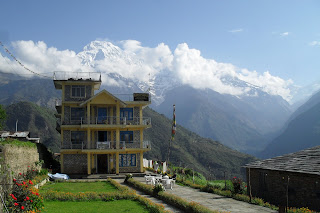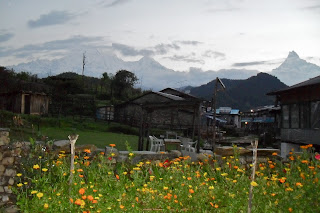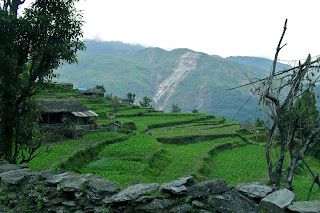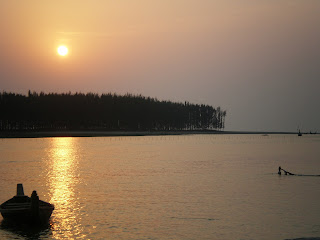I used to keep a blog.
It was about life in Chittagong, Bangladesh -- about experiences at the Asian University for Women, and happenings on the streets, and meals in hospitable homes, and escapes to the rural beauty of this shonar (golden) Bengal. Writing was a necessary escape too -- a chuti (vacation) that was healthy and therapeutic, along with cooking. Since taking a new, more intense position at AUW as director of the academic EFL program in which I taught last year, neither cooking nor writing have received enough of my attention. So I'm going to write this post, then bake some Irish soda bread.
I suppose it has only been two months since I last wrote, but my writer's block would suggest it has been much longer. Just to get myself back into it, I'm going to keep my musings simple today: I'm going to praise the vibrant colors that have been my drug this year. Doses of orange, teal, coffee, and grass are a visual therapy more easily obtained than a five-course meal or a page of prose.
ORANGE:
I went to Dhaka recently and finally bought one of the kantha blankets made by Hand and Cloth (please check out this wonderful business). Kantha is the traditional Bangladeshi design of a two-sided blanket made from vintage sari cloths. In Dhaka, I was spending the weekend with my friend who began Children's Uplift Programme, for homeless women and children in Dhaka. I had visited CUP a bit over a year ago and the women who were then just learning to sew kantha, as an alternative to the risks and abuses of street work, are now empowered by their livelihoods at Hand and Cloth. I bought my kantha blanket at North End Coffee roasters in Dhaka, and perhaps for the first time in my life, I strayed from my tendency to buy blue and green bedding, and I went for orange and red. I'm very happy with that decision.
DARK ROAST BROWN:
For me the drug of coffee is not solely in the caffeine, but in the entire sensory experience from the rich color of the beans, to the fragrance released while grinding, to the hot mug in my hands that gently draws me out of sleepy comas. North End Coffee Roasters has transformed the coffee addict's experience of life in Bangladesh. Started by Rick Hubbard it is the first and only coffee roasting company in Bangladesh. They're now delivering to Chittagong upon request, so every couple weeks or so I put in an order from AUW professors and a nice man named Monir shows up in a rickshaw at my apartment building with bags of coffee beans.
TEAL:
Soon, I'll write more about apartment 7-A in South Khulshi, but for now let's establish that I'm quite enamoured by this place I'm blessed to call home. The living room colors practically jump to greet me every time I enter, no matter how wilted I am. With some teal cushions picked out by my roommate Fatema, and an orange Pakistani cloth I picked up at a fair last year, we had our accent colors established. Coffee brown woods and tan sofa cushions provide the canvas for the spots of sea and sun.
GRASS GREEN
Finally, as long as there is daylight in South Khulshi, our hill outside needs no assistance in expressing it's audaciously perfect green flora. I see it outside my window when I wake up, and from the living room when I'm typing emails on a grey screen. Green. It's the color Bangladesh does best.
It was about life in Chittagong, Bangladesh -- about experiences at the Asian University for Women, and happenings on the streets, and meals in hospitable homes, and escapes to the rural beauty of this shonar (golden) Bengal. Writing was a necessary escape too -- a chuti (vacation) that was healthy and therapeutic, along with cooking. Since taking a new, more intense position at AUW as director of the academic EFL program in which I taught last year, neither cooking nor writing have received enough of my attention. So I'm going to write this post, then bake some Irish soda bread.
I suppose it has only been two months since I last wrote, but my writer's block would suggest it has been much longer. Just to get myself back into it, I'm going to keep my musings simple today: I'm going to praise the vibrant colors that have been my drug this year. Doses of orange, teal, coffee, and grass are a visual therapy more easily obtained than a five-course meal or a page of prose.
ORANGE:
I went to Dhaka recently and finally bought one of the kantha blankets made by Hand and Cloth (please check out this wonderful business). Kantha is the traditional Bangladeshi design of a two-sided blanket made from vintage sari cloths. In Dhaka, I was spending the weekend with my friend who began Children's Uplift Programme, for homeless women and children in Dhaka. I had visited CUP a bit over a year ago and the women who were then just learning to sew kantha, as an alternative to the risks and abuses of street work, are now empowered by their livelihoods at Hand and Cloth. I bought my kantha blanket at North End Coffee roasters in Dhaka, and perhaps for the first time in my life, I strayed from my tendency to buy blue and green bedding, and I went for orange and red. I'm very happy with that decision.
DARK ROAST BROWN:
For me the drug of coffee is not solely in the caffeine, but in the entire sensory experience from the rich color of the beans, to the fragrance released while grinding, to the hot mug in my hands that gently draws me out of sleepy comas. North End Coffee Roasters has transformed the coffee addict's experience of life in Bangladesh. Started by Rick Hubbard it is the first and only coffee roasting company in Bangladesh. They're now delivering to Chittagong upon request, so every couple weeks or so I put in an order from AUW professors and a nice man named Monir shows up in a rickshaw at my apartment building with bags of coffee beans.
TEAL:
Soon, I'll write more about apartment 7-A in South Khulshi, but for now let's establish that I'm quite enamoured by this place I'm blessed to call home. The living room colors practically jump to greet me every time I enter, no matter how wilted I am. With some teal cushions picked out by my roommate Fatema, and an orange Pakistani cloth I picked up at a fair last year, we had our accent colors established. Coffee brown woods and tan sofa cushions provide the canvas for the spots of sea and sun.
Finally, as long as there is daylight in South Khulshi, our hill outside needs no assistance in expressing it's audaciously perfect green flora. I see it outside my window when I wake up, and from the living room when I'm typing emails on a grey screen. Green. It's the color Bangladesh does best.


















































